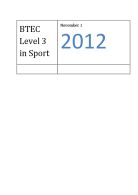The perimysium consists of sheets of connective tissue which separate the fibres into groups known as fascicles.
PIC 1
The epimysium surrounds the groups of fascicles that contain the muscle. Skeleton muscle is innervated and highly vascularised, due to its high energy needs, by penetration into the epimysium with branches into the peri- and endomysium. Connective tissue transmits the mechanical force of muscle. Tendons connect muscle to bone. The myotendinous junction occurs at the end of the muscle cell where the terminal actin filaments connect to the plasma membrane.
Muscle fibres develop from the fusion of many muscle precursor cells called myoblasts. Differentiation, which has been studied extensively, requires three stages.
Withdrawal from the cell cycle
- Production and assembly of muscle-specific proteins
Skeleton muscle fibres are mulinucleate cells that arise by fusion of mononucleate myoblasts. The many nuclei are located at the periphery of the cell. Mononucleate, satellite cells, associate with the muscle fibre and reside within the muscle basal lamina. They promote limited regeneration of muscle in an adult.
The structure of striated muscle cells. In the skeletal muscle structure is an example of how function follows from structure. The muscle fibre structure is highly organised and easy to understand, the language is hard.
PIC 2
Muscle fibres contain many myofibrils, which are organised arrays of myofilaments. Myofilaments are molecular filaments of two types. Thick filaments that are composed principally of myosin, and thin filaments, which are composed of actin.
PIC 3
Thick filaments are made of many myosin molecules. Each myosin molecule contains two myosin heavy chains and two pairs of light chains. Molecular heads make up the light chains. The myosin molecules associate by means of their tails to form the thick chain.
Thin filaments are made up from two chains of actin spiral wound around each other. Thin filaments also contain other proteins including tropomyosin and troponin that directs contraction.
The release of many myofilaments produces the myofibril, which shows the striations. The sarcomere is the basic contractile unit of a myofibril. Each myofibril contains many sarcomeres.
- The Z-disk delineates the borders of sarcomeres.
- Thin filaments attach to a Z-disc at their plus ends
- Thick filaments are centred between the Z-discs.
Levers
A lever is a mechanical system that creates movement. It either has a pivot or a fulcrum, a force that generates the movement, a resistance load or weight that is moved, a lever arm which applies.
The application of a force to the lever arm causes the arm to rotate around the pivot or fulcrum, causing the load or resistance to move.
Class 1 lever:
The fulcrum is in between the load and the effort.
E
F
L
Note that if the system is in balance the principle of movement applies. An example from a human joint complex is the action of the triceps muscle on the elbow joint
The effort lies in the muscle, the fulcrum at the elbow joint and the load at the hand exerting a force.
Class 2 lever:
Where the load lies between the effort and the fulcrum
In this type of lever the fulcrum is at one end of the lever arm, the effort at the other end, the load is between the fulcrum and the effort.
Note: because of the rotational nature of a lever system load and effort must move in opposite direction – clockwise or anti-clockwise.
An example of this type of lever in the human body is the ankle joint.
Class 3 lever:
The fulcrum and load are at opposite ends of the lever arm, with the effort somewhere in the middle. In this case the effort is always larger than the load, since the effort is nearer the fulcrum.
This is the most common class of lever to be found in the human joint complexes. For example the biceps curl.







